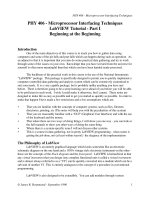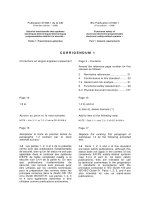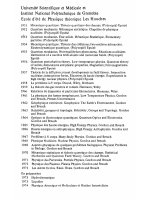Part 1 bolt failtures 02 2004
Bạn đang xem bản rút gọn của tài liệu. Xem và tải ngay bản đầy đủ của tài liệu tại đây (2.79 MB, 18 trang )
Decreasing Bolt and Bearing
Failures on Process Rolls
For Vibration Institute
Piedmont Chapter
Ken Singleton
Bob Bracher
1. Background
2. Review of Roll-Shaft Reliability Problem Areas
3. Detection
• Vibration
• Modal Analysis
• Rotor Modeling
• Bump Testing
4. Correction
5. Results of the reliability efforts.
2
Background
The focus of this case study was the Failures of Shaft-Roll Bearings
and Bolts of shaft-roll assemblies in a fiber manufacturing plant.
The project was initiated because bolt and bearing failure rates were
considered too high and the unexpected failures were having a major
impact on plant production and reliability of the operating equipment.
A review was made to identify the root cause of the bearing and bolting
failures.
Roll
Bolted
Connection
Spherical
Roll Brg
Shaft
Spherical
Roll Brg
3
Shaft Roll Reliability Problem Areas
1. Bolts & Joint Integrity
4
Bolts & Joint Integrity
The rolls were bolted to the end of the shafts using 16 - 1 ¼ inch SOHC Bolts.
Analysis of bolt failures indicated cyclic fatigue failures were the most
common.
This bolting failure allowed the
roll to drop off the shaft during
operation.
5
Bolts & Joint Integrity
The rolls were bolted to the end of the shafts using 16 - 1 ¼ inch SOHC Bolts.
Analysis of bolt failures indicated cyclic fatigue failures were the most
common.
12 of the 16 1 ¼” Socket Head Bolts
failed at the head.
It appeared that bolt 16 failed 1st,
then bolts 13 & 14.
Bolts 3 thru 8 failed last.
Note fretting damage on the shaft
face. Fretting was often observed
on the shaft and roll mating faces
indicating extended operation with
a loose joint allowing relative
motion.
6
Bolts & Joint Integrity
This bolt failed at the surface of
the shaft. Note loss of shaft
material around the tapped hole
indicating cyclic loading.
The mating surfaces of the shaft
and roll were designed to be
clamped by 16 1 ¼ bolts preloaded
to about 120,000 lbs each. The
design clamping force calculated to
1,920,000 lbs.
Fretting corrosion and bolt failure
in fatigue indicated that the bolts
were not seeing the design loading.
Contributors to Failure:
Shallow tapped holes in the shafts
Incorrect thread lube
Failure to use a lubricant
Inadequate torque
Rough machined clamping surfaces
7
Bolts & Joint Integrity
The shaft failed in
cyclic fatigue in
bending.
The stress riser was
caused by a sharp
machined corner on
the shaft OD.
8
Bolts & Joint Integrity
Nine bolts failed on this shaft-roll.
9
Bolts & Joint Integrity
Findings:
Cyclic fatigue failures of bolting were the most commonly reported problem.
10
Bolts & Joint Integrity
Findings:
Cyclic fatigue failures of bolting were the most commonly reported problem.
There were inconsistent assembly practices:
Using various torque values
Use and non-use of anti-seize on bolt threads and under the heads
Bolt binding due to hole location inaccuracy and hole angularity error
(machining errors).
11
Bolts & Joint Integrity
Findings:
Cyclic fatigue failures of bolting were the most commonly reported problem.
There were inconsistent assembly practices:
Using various torque values
Use and non-use of anti-seize on bolt threads and under the heads
Bolt binding due to hole location inaccuracy and hole angularity error
(machining errors).
The finish and machining tolerances of mating surfaces of the shaft & rolls
were not being held by the repair shops.
12
Bolts & Joint Integrity
Findings:
Cyclic fatigue failures of bolting were the most commonly reported problem.
There were inconsistent assembly practices:
Using various torque values
Use and non-use of anti-seize on bolt threads and under the heads
Bolt binding due to hole location inaccuracy and hole angularity error
(machining errors).
The finish and machining tolerances of mating surfaces of the shaft & rolls
were not being held by the repair shops.
There was no inspection process to enforce tolerances at the vendor repair
shops.
13
Bolts & Joint Integrity
The inside surface of roll
ends, which a bearing plate
clamped, was often very
rough.
The bearing plate mating
surface had approximately
125 to 250 rms finish. A 32
finish was called out on the
drawing.
Compression of the material
in the high tool mark ridges
during normal operation
could be a contributor to the
bolted joint loosening.
14
Bolts & Joint Integrity
Findings:
Cyclic fatigue failures of bolting were the most commonly reported problem.
There were inconsistent assembly practices:
Using various torque values
Use and non-use of anti-seize on bolt threads and under the heads
Bolt binding due to hole location inaccuracy and hole angularity error
(machining errors).
The finish and machining tolerances of mating surfaces of the shaft & rolls
were not being held by the repair shops.
There was no inspection process to enforce tolerances at the vendor repair
shops. Processes were developed and put in place to inspect and document
findings.
The bolt head contact area was often less than 80% which likely contributed
to bolt head failures. This was caused by the shaft bolt hole angularity
tolerance not being enforced.
15
Bolts & Joint Integrity
Findings:
Cyclic fatigue failures of bolting were the most commonly reported problem.
There were inconsistent assembly practices:
Using various torque values
Use and non-use of anti-seize on bolt threads and under the heads
Bolt binding due to hole location inaccuracy and hole angularity error
(machining errors).
The finish and machining tolerances of mating surfaces of the shaft & rolls
were not being held by the repair shops.
There was no inspection process to enforce tolerances at the vendor repair
shops. Processes were developed and put in place to inspect and document
findings.
The bolt head contact area was often less than 80% which likely contributed
to bolt head failures. This was caused by the shaft bolt hole angularity
tolerance not being enforced.
Many shaft bolt holes were tapped too shallow which caused the bolts to
bottom, preventing adequate clamping of the joint and stretching of the bolt
16
thus causing bolt fatigue failure.
In this case of a loose roll, the bolt threads were deformed the last
1/2 “ indicating the holes were not tapped deep enough with fully
formed threads.
The lack of design preloading of the bolt resulted in insufficient joint
clamping force.
17
Shaft Roll Reliability Problem Areas
1. Bolts & Joint Integrity
2. Bearings
18









